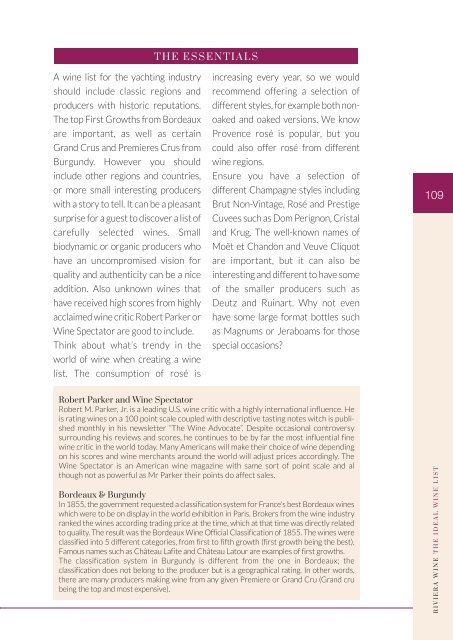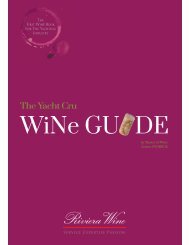Riviera Wine - Catalogue 2018
Create successful ePaper yourself
Turn your PDF publications into a flip-book with our unique Google optimized e-Paper software.
THE ESSENTIALS<br />
A wine list for the yachting industry<br />
should include classic regions and<br />
producers with historic reputations.<br />
The top First Growths from Bordeaux<br />
are important, as well as certain<br />
Grand Crus and Premieres Crus from<br />
Burgundy. However you should<br />
include other regions and countries,<br />
or more small interesting producers<br />
with a story to tell. It can be a pleasant<br />
surprise for a guest to discover a list of<br />
carefully selected wines. Small<br />
biodynamic or organic producers who<br />
have an uncompromised vision for<br />
quality and authenticity can be a nice<br />
addition. Also unknown wines that<br />
have received high scores from highly<br />
acclaimed wine critic Robert Parker or<br />
<strong>Wine</strong> Spectator are good to include.<br />
Think about what’s trendy in the<br />
world of wine when creating a wine<br />
list. The consumption of rosé is<br />
increasing every year, so we would<br />
recommend offering a selection of<br />
different styles, for example both nonoaked<br />
and oaked versions. We know<br />
Provence rosé is popular, but you<br />
could also offer rosé from different<br />
wine regions.<br />
Ensure you have a selection of<br />
different Champagne styles including<br />
Brut Non-Vintage, Rosé and Prestige<br />
Cuvees such as Dom Perignon, Cristal<br />
and Krug. The well-known names of<br />
Moët et Chandon and Veuve Cliquot<br />
are important, but it can also be<br />
interesting and different to have some<br />
of the smaller producers such as<br />
Deutz and Ruinart. Why not even<br />
have some large format bottles such<br />
as Magnums or Jeraboams for those<br />
special occasions?<br />
109<br />
Robert Parker and <strong>Wine</strong> Spectator<br />
Robert M. Parker, Jr. is a leading U.S. wine critic with a highly international influence. He<br />
is rating wines on a 100 point scale coupled with descriptive tasting notes witch is published<br />
monthly in his newsletter “The <strong>Wine</strong> Advocate”. Despite occasional controversy<br />
surrounding his reviews and scores, he continues to be by far the most influential fine<br />
wine critic in the world today. Many Americans will make their choice of wine depending<br />
on his scores and wine merchants around the world will adjust prices accordingly. The<br />
<strong>Wine</strong> Spectator is an American wine magazine with same sort of point scale and al<br />
though not as powerful as Mr Parker their points do affect sales.<br />
Bordeaux & Burgundy<br />
In 1855, the government requested a classification system for France's best Bordeaux wines<br />
which were to be on display in the world exhibition in Paris. Brokers from the wine industry<br />
ranked the wines according trading price at the time, which at that time was directly related<br />
to quality. The result was the Bordeaux <strong>Wine</strong> Official Classification of 1855. The wines were<br />
classified into 5 different categories, from first to fifth growth (first growth being the best).<br />
Famous names such as Château Lafite and Château Latour are examples of first growths.<br />
The classification system in Burgundy is different from the one in Bordeaux; the<br />
classification does not belong to the producer but is a geographical rating. In other words,<br />
there are many producers making wine from any given Premiere or Grand Cru (Grand cru<br />
being the top and most expensive).<br />
RIVIERA WINE THE IDEAL WINE LIST







